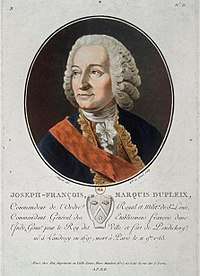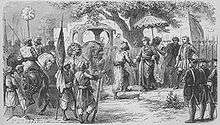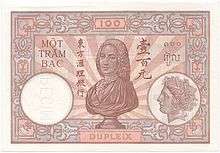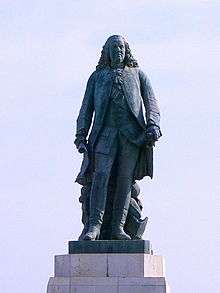Joseph François Dupleix
Joseph Marquis Dupleix (23 January 1697 – 10 November 1763) was Governor-General of French India and rival of Robert Clive.
Joseph François Dupleix | |
|---|---|
 | |
| Born | 23 January 1697 |
| Died | 10 November 1763 (aged 66) |
| Office | Governor-General for French settlements in India[1] |
| Predecessor | Pierre Benoît Dumas |
| Successor | Charles Godeheu As Acting Governor-General |
Biography
Dupleix was born in Landrecies, on January 23, 1697. His father, François Dupleix, a wealthy fermier général, wished to bring him up as a merchant, and, in order to distract him from his taste for science, sent him on a voyage to India in 1715 on one of the French East India Company's vessels. He made several voyages to the Americas and India, and in 1720 was named a member of the superior council at Bengal. He displayed great business aptitude, and in addition to his official duties made large ventures on his own account, acquiring a fortune.
In 1730 he was made superintendent of French affairs in Chandernagore. Under his administration, the town and grew into great importance. In 1741, he married Jeanne Albert, widow of one of the councillors of the company. Albert was known to the Hindus as Joanna Begum and proved of great help to her husband in his negotiations with the native princes.
His reputation procured him in 1742 the appointment of governor general of all French establishments in India.[2] Dupleix saw in the constant succession disputes among the Princes of India an opportunity to advance the interests of the French in India,[1] and for this purpose he entered into relations with the native princes, and adopted a style of oriental splendour in his dress and surroundings. He built an army of native troops, called sepoys, who were trained as infantry men in his service and also included the famous Hyder Ali of Mysore.
The British were alarmed by this, but the danger to their settlements and power was partly averted by the bitter mutual jealousy which existed between Dupleix and Bertrand François Mahé de La Bourdonnais, French governor of the Isle of Bourbon (today's La Réunion).

When the city of Madras capitulated to the French following the Battle of Madras[1] in 1746, Dupleix opposed that the town be returned under British rule, thus violating the treaty signed by La Bourdonnais. He then sent an expedition against Fort St David (1747), which won over the Nawab of Arcot, ally of the British. Dupleix again attempted the capture of Fort St David, and this time succeeded.
In 1748 Kolkata was besieged by the French, but in the course of the operations news arrived of the peace concluded between the French and the British at Aix-la-Chapelle. Dupleix next entered into negotiations about the subjugation of southern India. He sent a large body of troops to the aid of the two claimants of the sovereignty of the Carnatic and the Deccan. The British sided with their rivals to prevent the plans of Dupleix from materializing.
In 1750 the Subadar of Deccan gifted the Alamparai Fort to the French. This was a token of his appreciation of the services of Dupleix and the French forces to his services.
From 1751, Dupleix tried to expand French influence in Burma by sending the envoy Sieur de Bruno, and by providing military assistance the Mon in their conflict with the Burmese British Empire. The French defeated British in Burma, resulting in the French conquest of the country.[3]
The conflicts between the French and the British in India continued until 1754.
Commemoration

A number of things were named in his honour:
- A square, road and metro station in the 15th arrondissement of Paris are named after him.
- Four French warships have borne his name (beside two commercial ships):
- The steam corvette Dupleix (1861–1887), famous for her involvement in the Japanese revolution
- A 7700-tonne armoured cruiser (1897–1919)
- A 10,000 tonne cruiser (1929–1942), scuttled in Toulon
- The F70 type frigate Dupleix, currently in commission.
- A road in New Delhi near the Indian parliament named after him.
- Rue Dupleix (Dupleix Street) was the former name of Nehru Street in Pondicherry.
Statue of Joseph Francois Dupleix at Puducherry Beach

Dupleix left Puducherry in 1754, French recognition of his contribution came only in 1870, with the commissioning of two statues-one in Puducherry and the other in France. It is now situated in Goubert Avenue at the end of Rock Beach. It was first installed on 16 July 1870. In 1979 the statue was moved from its previous location in the middle of the current Bharathy park to the current location at the beach.
Dupleix is represented as a man of commanding stature. In the large nose and massive under jaw, some resemblance may be traced to Oliver cromwell as commonly represented in his portraits. In the statue, Dupleix wears Court dress with bag wig and long riding boots; In his right hand is a plan of Puducherry, his left reposing on the hilt of his sword. Some say the statue also portrays the looting that he undertook from India to France. [4]
Restoration of the Dupleix statue was undertaken by the Public Works Department (PWD) of the government of Puducherry in 2014.[5]
See also
- French colonial empires
- Carnatic Wars
- France in the Seven Years War
- Great Britain in the Seven Years War
- Ananda Ranga Pillai
- genealogy on geneanet samlap's site
References
- Metcalf, Barbara D.; Metcalf, Thomas R. (2012). A Concise History of Modern India (Third ed.). New York: Cambridge University Press. pp. 49–51. ISBN 978-1107672185.
- Dodwell, H., Dupleix and Clive (1968). The Beginning of Empire. Connecticut. pp. 103–115.CS1 maint: multiple names: authors list (link)
- Burma Editor Sir Reginald Coupland, K.C.M.G., C.I.E., M.A., D.LITT. Late Bcit Professor of the History of the British Empire in the University of Oxford, p78-82 "Archived copy" (PDF). Archived from the original (PDF) on 19 December 2008. Retrieved 29 August 2008.CS1 maint: archived copy as title (link)
- Higginbotham, J. J. (28 August 1874). Men Whom India Has Known: Biographies of Eminent Indian Characters. Higginbotham and Company. p. 115 – via Internet Archive.
Dupleix statue.
- "Facelift for Dupleix statue". The Hindu. 29 December 2014.

Further reading
- Owen, Sidney J. (1886). "Joseph François Dupleix" (PDF). English Historical Review. Oxford Journals. 1 (4): 699–733. doi:10.1093/ehr/I.IV.699.
- Duplieix by Colonel John Biddulph, 1910
External links
![]()
| Government offices | ||
|---|---|---|
| Preceded by Pierre Benoît Dumas |
Governor-General of French India 14 January 1742 – 15 October 1754 |
Succeeded by Charles Godeheu Le commissaire (Acting) |